 |
|

|
 |
TABLE of CONTENTS
 |
New safety campaign aims to reduce slips, trips and falls by 25% |
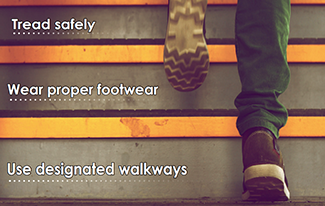
MnDOT’s goal is to reduce the monthly the number of slip, trip and fall injuries by 25% compared to the previous year. |
By Stephanie Raley, Safety Culture Director
Last year, there were 82 slip, trip and fall injuries reported by MnDOT employees. This calendar year, the agency is on pace to meet or exceed that number.
Injuries can many ripple effects. They can impact an employee’s personal life, including their plans, activities and quality of life. A slip, trip and fall injury may also result in an unplanned employee absence. These unplanned absences are linked to increased workload, higher stress levels and disruption to other employees’ work, and can reduce the quality of the work output.
Even though MnDOT has policies, procedures, awareness training and physical controls like traction devices, the agency has not seen a reduction in slip, trip and fall injuries—in fact, the OSHA Recordable Rate for employee incidents at MnDOT is 1.8 times higher than the industry average.
The next safety campaign, starting in November, will target reducing slip, trip and fall injuries starting in November. The goal is to reduce the monthly number of these injuries by 25% compared to the previous year.
What causes slips, trips and falls in the workplace? Nationally, a small portion of the incidents were attributed to poor lighting (1%), stairs (2%) and ladders (2%). The other 95% was split between just three causes:
- Housekeeping issues (lack of tidiness): 16%
- Wet or slippery surfaces: 25%
- Human factors (rushing, frustration, fatigue, complacency): 54%
To effectively deal with slips, trips and falls, it’s important to maintain efforts to eliminate physical hazards related to housekeeping issues and wet or slippery surfaces. However, the safety team also encourages employees to focus more on human factors. Physical hazards wouldn’t be a problem if everyone was aware of their surroundings 100% of the time—but, of course, this isn’t the case. People get distracted and take their eyes and minds off the task at hand.
People carry out 40% of their daily activities by habit, rather than based on conscious decision. On the safety front, bad habits include texting and walking, walking too fast, not looking around corners and not looking out for things like wet floor signs. Habits are patterns of behavior, and the bad ones need to be replaced with good ones. Making this intentional change can help you can fall back on good behavior when your decision-making capability is compromised by human factors like rushing, distraction, fatigue, and complacency. Research shows it takes an average of 66 days to form a new habit, and safety campaigns like this are a great way to help build habits that keep you safe.
What can YOU do?
All employees have a shared responsibility in our personal safety. These include:
- Actively participate in training and put what you learn to good use
- Recognize when you are rushing, tired, distracted or complacent and adjust actions accordingly
- Report housekeeping and maintenance issues so they can be addressed
- Participate in the agency’s safety culture
- Make an honest effort to build better habits
- Be knowledgeable of and follow workplace policies and procedures

For more tips and guidance, review MnDOT’s Motor Vehicle and Equipment Backing Safety Directive. This information, and all safety directives, can be found on MnDOT’s online Workplace Safety Planner by clicking the My Safety icon on your computer desktop.
|
|
 |
|

|
 |
TABLE of CONTENTS
|
MnROAD testing redirects section of I-94 |
By Anne Meyer
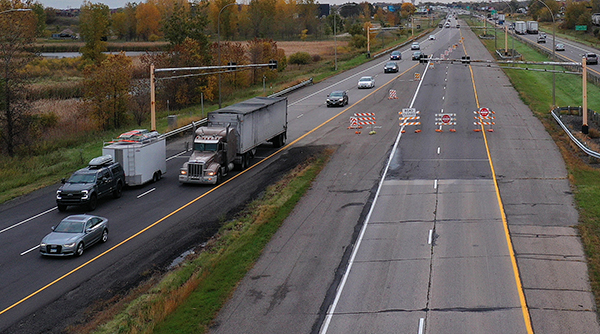
On October 12, MnDOT shifted traffic on westbound I-94 between Albertville and Monticello onto lanes within the MnROAD facility. The shift is part of new pavement testing projects studying a variety of sustainable and recycled materials within the pavement. In July, crews paved the 3.5-mile test area into 39 new sections: 20 with asphalt and 19 with concrete. Each section contains different materials like fibers, recycled plastic bottles and other environmentally sustainable products; MnROAD is studying how these mixtures perform under heavy traffic and in colder weather conditions. Hundreds of sensors underneath the test pavement record temperature, moisture, strain on the pavement under traffic and other data to aid researchers during the project. Check out the MnROAD website to learn more. . Drone photo by Rich Kemp |
|
 |
|

|
 |
TABLE of CONTENTS
|
Research explores roadside plants as "living saltwater runoff interceptors" |
By Joseph Palmersheim
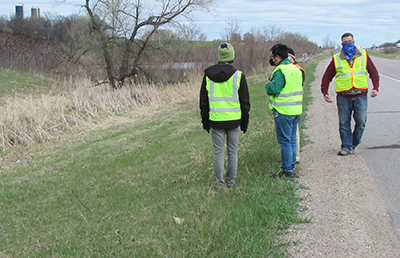
Coming soon to a roadside near you? Researchers from the University of Minnesota are partnering with MnDOT to find a roadside plant mixture that not only tolerates salt, but thrives on it. Testing started in April 2021 at several roadside-adjacent plots of land at the MnROAD facility. The plants, called halophytes, exist naturally in areas of high salinity, like salt marshes. This picture, taken near a roundabout project in Hibbing, shows what beneficial halophytes can look like in a landscape setting. Photo by Dwayne Stenlund |
MnDOT is partnering with the University of Minnesota on preliminary research to find a roadside plant mixture that not only tolerates salt but thrives on it.
Testing started in April 2021 at several roadside-adjacent plots of land at the MnROAD facility. The plants, called halophytes, exist naturally in areas of high salinity, like salt marshes.
This research project is evaluating plants as proof-of-concept, looking at how well they capture salt from a less-naturally occurring event: using salt on roads in winter.
If all goes to plan, these plants could be enlisted to intercept and retain a portion of spring’s first flush of high-salt residues, and keep it from the state’s stormwater systems and groundwater. In addition, the plant roots could capture the salt residues that enter the soil throughout the remaining duration of normal vegetation growth during spring through fall.
These living saltwater runoff interceptors won’t look like grandma’s roses, though.
“These are not nice-looking plants,” said Dwayne Stenlund, a natural resource specialist and certified professional in erosion and sediment control. “Most of these have thick leaves and stems, so they don't look delicate or beautiful. They are a bit different and might even look weedy. These plantings would be meant mostly for rural areas or around urban stormwater ponds and basins. We’re using a combination of 12 plant species that show promise of salt uptake and retention.”
The agency isn’t spending direct funds on this research, at least not at this time. Instead, MnDOT is providing a testing location that has potentially knowable amounts of applied sodium chloride used over the winter season and climate changing deicing operations.
Dr. Bo Hu, a University of Minnesota professor, runs a research group focusing on the development of bioprocessing and bioengineering technologies. He contacted Stenlund to see about testing halophytes and other salt binding species in a real-life roadside scenario at MnROAD.
It takes a special kind of plant to grow and tolerate a natural desiccant and organic preservative. Capturing the road salt would be one benefit – but Stenlund sees another.
“The concept here is to develop something that has a market,” he said. “Wildlife is typically short of salt, which may partially explain why they feed along our roadsides. That's why hunters and the cattle industry put salt licks out. In this case, the intent is to develop private market opportunities for harvest of plant biomass and transformed using bio-engineered processes as a beneficial feed additive for the cattle or pig industry, with toxins and deleterious elements removed. This is more than just temporary salt capture. It's the harvest and removal that makes this research idea special.”
The MnROAD tests will show how much salt the plants can take up, how well they can survive Minnesota’s winters, timing for ideal salt harvest and effects of the harvest process (through simulated mowing). Researchers expect that the greenhouse-screened plant species will survive differently within roadsides than those established under ideal conditions. As a result, researchers will also learn how best to grow these plants under “non-ideal conditions.”
If the research pans out, MnDOT and other places could potentially see these salt-capturing plants in use within five years, Stenlund estimates.
“This idea of using plant biomass for salt sequestration, harvest and reuse is one in a toolbox of emerging options designed to lower the impacts of salt on ground and surface waters,” he said. “We’re trying to get ahead of the curve and be progressive rather than reactionary while still providing a safe and efficient transportation system.” |
 |
|

|
 |
TABLE of CONTENTS
|
New well-at-work guidance now in effect, health screening no longer required |
|
By Doug Mack
As of October 17, MnDOT has updated its policies regarding workplace health. This includes developing new Well at Work guidance (HR/LR Memo #2022-1) and ending the requirement that employees complete a health screening before entering the workplace. The shift follows updated guidance from the Centers for Disease Control and Prevention.
Wellness considerations
The primary focus of the new Well at Work guidance is on keeping the workplace healthy by encouraging employees to stay home when they are sick.
As discussed in recent Note Mailer from Director of Human Resources Karin van Dyck, it is particularly important that employees stay home if they have symptoms associated with COVID-19 and either have not been tested or are awaiting results. Those symptoms include:
- Fever of 100.4° Fahrenheit or higher, or feeling feverish (e.g., chills or sweating)
- A new cough
- New shortness of breath or difficulty breathing
- Unusual fatigue
- Muscle or body aches unrelated to exercise
- New headache
- New loss of taste or smell
- A new sore throat
- New congestion or runny nose
- New nausea/vomiting or diarrhea
Employees with any of those symptoms are encouraged to use accrued sick time, take a COVID-19 viral test as soon as possible, and follow Centers for Disease Control (CDC) guidance. Workers who have been exposed to COVID-19 or have been told by a healthcare provider or public health authority that they were exposed should follow current CDC guidance for individuals exposed to the virus.
Options for work or leave
Employees who have symptoms of COVID-19 or who have received a positive COVID-19 test result and are able to perform work despite their illness should discuss with their supervisor whether their job duties can be performed through telework. Approval for telework is at the discretion of the employee’s supervisor/manager. Employees should use accrued sick leave if they are unable to report to work and unable to telework. Employees who do not have accrued sick leave may request to use accrued vacation or accrued compensatory time or take unpaid time off if they are unable to report to work and unable to telework.
Employees who need to quarantine or isolate, cannot telework, and need additional time off after the CDC-recommended quarantine/isolation period should contact their agency’s FMLA or ADA coordinator.
Test-and-treat options available
As a reminder, many COVID-19 testing sites in Minnesota and across the country also offer prescriptions to those who test positive so they can get medications to treat the virus right away. You can search the federal website for the test-and-treat location nearest you.
Health screening history
The health screening had been in place since April 5, 2020, when it was established to preventative measure to stop the spread of COVID-19 in the workplace. Anthony Cairns in the Office of Human Resources said that the agency has used information from the daily health screening and COVID testing results to evaluate conditions and adjust its response accordingly. This has included:
- Forecasting Equipment Needs for telecommuters
- Forecasting Hygiene and Protective Needs for In-Office Employees
- Contact Tracing for workplace exposures
- Office/Workspace requirements for in-office employees
- Forecasting the number of weekly Covid Test required
- Determining the number of available employees for various types of work
- Tracking overall COVID-19 trends in collaboration with other agencies
Monitoring this information helped MnDOT adapt to shifting conditions, said Cairns, but also provided useful lesson for the long term: “We learned how to monitor and redeploy our workforce in new and creative ways as attendance and working conditions changed rapidly.”
More information
Additional details about the Well-at-Work guidance can be found on the MMB website. |
 |
|

|
 |
TABLE of CONTENTS
 |
Staffing updates |

Steve Misgen. |
Steve Misgen is new operations and maintenance director for the Metro District
Steve Misgen has accepted the operations and maintenance director mobility position within the Metro District. In his new role, he will provide managerial, strategic leadership, and oversight direction to the Metro’s Operations, Maintenance and Toward Zero Deaths programs.
Misgen has been part of Metro’s Traffic Office since 1995 and the Metro Traffic Engineer since 2007. He also previously held this position in 2016.

Jeff Brunner. |
Jeff Brunner is new office director for Office of Materials and Road Research
Jeff Brunner, who had been the research section manager for the Office of Materials and Road Research, has stepped into a new role as OMRR’s acting office director.
Brunner takes over for Glenn Enstrom, who has retired. Brunner has worked for MnDOT since 1984, when he started as a student worker. |
| |
|

|
|

|
 |
TABLE of CONTENTS
 |
Combined Charities campaign begins with message from Lt. Gov. Flanagan |
The 2022 Combined Charities campaign is now underway, kicking off with a video message from Lt. Gov. Peggy Flanagan.
“Minnesota charities and nonprofits need our support to keep doing their important work in communities across our state,” Flanagan said.
Since 1991, state employees have raised more than $25 million for Minnesota charities through voluntary payroll deductions. This funding has helped support many different organizations that provide health, education, environmental, arts and social service programs throughout Minnesota.
To set up a recurring donation, go to the Self Service Portal and follow these directions:
- Select My Pay
- Select Charitable Deductions. From this page, you can review, add, or update voluntary deduction information.
For more information and to learn more about participating federations, head to the State of Minnesota Combined Charities website.
Video of Lieutenant Governor Peggy Flanagan delivering kickoff message for the 2022 Combined Charities Campaign. |
|
| |
|

|
 |
TABLE of CONTENTS
 |
New library materials available |
By Jim Byerly, Electronic Resources Librarian
The latest issue of New Library Materials is available. This issue features “Racial Justice: The Insights You Need from Harvard Business Review” (print and ebook), published by Harvard Business Press.
New Library Materials is a compilation of resources added to the library collection during the previous month. Visit the library website and click New Library Materials to sign up. Questions and feedback are welcome at Ask a Librarian. |
|
|
|

|
 |
TABLE of CONTENTS
|
On the Job: Christian Lawien maintains traffic infrastructure |
By Rich Kemp

Christian Lawien. |
Christian Lawien is the assistant district traffic engineer in District 1. He started at MnDOT as a student worker and then came back in March 2020.
What has been your career path up to this point?
It began in 2010 when I was hired as a student worker in the District 1 Traffic Office, where I worked on collecting sign inventory information and inputting that information into SignTrack. I also conducted traffic counts for MnDOT’s annual count program. I stayed at MnDOT as a student worker until 2012, when I graduated college. I went on to work in consulting as a municipal engineer until coming back to MnDOT in 2020, where I was initially hired as a project manager in the District 1 Project Development Office. When a position became open in Traffic later that year, I decided to return to my passion of traffic engineering. Because of my experience in project management, I was encouraged to keep managing some projects and was asked to help manage projects for the district Local Partnership Program.
What do you do in your job?
I primarily take care of maintaining traffic-related infrastructure from an engineering standpoint. I respond to public inquiries involving traffic-related items and make plans to address those concerns if necessary. I oversee the district’s signing and pavement markings. I review entrance and event permits from a traffic perspective. I also act as the district count manager for the traffic counting program and supervise employees who conduct our traffic counts, and I’m one of the tort claim liaisons for the district. Beyond these tasks, I help oversee the district’s LPP and manage those projects on the MnDOT side. Finally, I act as project manager for signing and other traffic standalone projects and as a plan reviewer for those projects.
What is a typical day like?
I would say no day is typical. Some days I’m busy responding to multiple customer inquiries, some days I’m primarily reviewing permits and other days I’m primarily reviewing plans for a sign replacement project to just give a few examples. I mostly work from home and utilize multiple software programs to do my job. I love getting out to a project site and doing field reviews but those are few and far between.
What is your favorite part about your job?
It’s hard to pinpoint an absolute favorite part because there are many. I really enjoy the people I work with and having access to such a large and diverse group of employees with expert knowledge in so many different areas. I know that if I don’t know the answer, I can find it by reaching out to someone.
What are the biggest challenges?
One of the biggest challenges in my position is communicating with the public. Sometimes I have to handle calls from someone who just lost a loved one or saw a horrific event due to a traffic crash and understandably want something done to try and prevent another tragedy. A lot of times our short-term solutions are limited to signing, but signing is, unfortunately, proven to have little effect on traffic safety.
What kind of changes have you seen in your job?
My most recent employment at MnDOT has only been for the last two-and-a-half years and I started at the beginning of the pandemic, so I have not seen a lot of change personally. I have noticed that MnDOT was very resilient during the pandemic and teleworking was far more productive than I ever imagined it could be. I think there is great opportunity ahead as we transition into hybrid work to capitalize on the positives of teleworking and working in person. Since my student worker days, I have noticed that MnDOT has become much more inclusive and supportive. I have also noticed that different departments collaborate and work much more closely together than they did just a decade ago. These changes are encouraging and make employees happier and more productive.
I look forward to seeing what the future has in store for MnDOT and the ways I can grow in my career and be of service to the people of Minnesota. I am proud to be a part of Team MnDOT!
Do you or a co-worker have an interesting job to share with readers? Send us your ideas, and we’ll contact you for more information.
Recent employee profiles:
|
 |
|

|
 |
TABLE of CONTENTS
|
FUEL promotes National Disability Employment Awareness Month |
By Kenneth Rodgers, Office of Equity & Diversity

|
Observed annually in October, National Disability Employment Awareness Month celebrates the contributions of America’s workers with disabilities past and present and showcases supportive, inclusive employment policies and practices. This year’s theme is “Disability: Part of the Equity Equation.”
NDEAM is led by the U.S. Department of Labor’s Office of Disability Employment Policy, but it includes many observances held at the grassroots level across the nation every year. The Campaign for Disability Employment encourages organizations of all sizes and in all industries to participate.
Over the years, the MnDOT employee resource group dedicated to disability awareness, Fully Utilizing Employees Without Labeling, also known as FUEL, has sponsored activities to help employees without disabilities understand the varied methods that their colleagues with disabilities use in their daily work. One example is the “No Mouse Challenge,” in which employees use their computers without a mouse for navigating for a period of 10-15 minutes. The challenge is to only use your arrow keys or your tab key to move your cursor around the page, wherever you want it to go, no clicking allowed.
Many people attempting the challenge have the same kinds of reaction:
- “What?! How can I move the cursor where I need it to be on my screen if I can’t use my mouse?”
- “This is an impossible task and way too frustrating for me to try for more than just a minute!”
- “There is no way I can get my cursor where I need it to be!”
- “This is a trick test and impossible to do, right?”
Yet, employees without sight or who are unable to manipulate a mouse do this each and every day, week after week, without frustration, and manage quite well. (In fact, sometimes using keyboard commands is easier than using a mouse—in a Teams meeting, instead of looking for the microphone icon to mute or unmute yourself, try pressing the Control, Shift and letter M buttons at the same time to turn your microphone on or off.)
The point of the No Mouse Challenge is to help those without the need start think about how someone else might do this exact task differently; it is a reminder that people do not all have to do the same thing exactly the same way. The global lesson is to broaden our own perspectives from a limited awareness of how we might do things to a more inclusive understanding that there is more than one way to do almost everything. It also serves as a reminder that accessibility is part of the the goals of diversity, equity and inclusion. There is a rapidly growing movement in the DEI arena where organizations are adding “accessibility,” turning the term into DEIA.
Another potential challenge, in honor of National Disability Employment Awareness Month: Consider joining FUEL. The group includes both employees with disabilities and others who don’t have disabilities but are allies who support building greater awareness at MnDOT. The monthly virtual meetings include conversations and provide a safe place to just be yourself, with or without a disability. The group’s goal is to build a wider awareness and acceptance, helping people across the agency see every MnDOT employee as a fully contributing and equal member of the workforce, without the need to have to use a label.
To be added to the FUEL mailing list, send a request to Frida Alvarez. |
 |
|

|
 |
TABLE of CONTENTS
|
Students get moving for Walk & Bike to School Day |
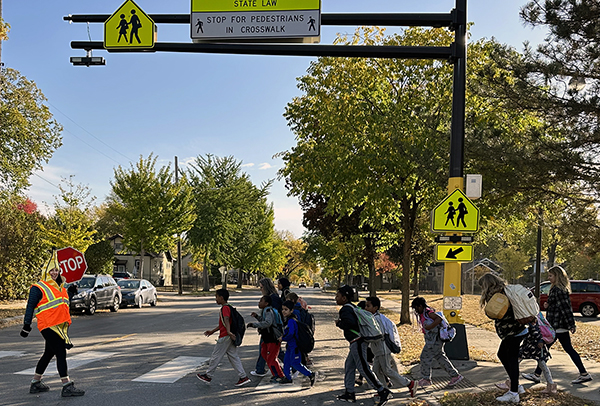
These students in Minneapolis were among the thousands of people taking part in International Walk & Bike to School Day on October 12. This annual event, sponsored by Minnesota Safe Routes to School, encourages students and parents to practice safe biking and walking activities. Gov. Tim Walz proclaimed October 12 as “Walk & Bike to School Day” in Minnesota.
Walk & Bike to School Days are special one-day events to help make biking and walking more visible, fun and rewarding for children. These events can encourage parents and students to make biking and walking to school a habit.
. Photo by Dave Cowan |
|
 |
|

|
 |
TABLE of CONTENTS
|
SMTP receives two public engagement awards |
By Hally Turner, Transportation System Management

Here is an example of a comic translated into Somali.
|
Minnesota’s highest transportation policy plan, the Statewide Multimodal Transportation Plan, recently won two public engagement awards.
The first honor was from the Minnesota chapter of the American Planning Association, which selected the SMTP for the Excellence in Community Engagement award. Staff accepted the award at a ceremony held on September 22 at the 2022 APA MN Conference in Duluth.
The other award is from the Transportation Research Board Committee on Public Engagement & Communications, which selected the SMTP from 30 projects to receive the Communicating Concepts with the Public Competition award. MnDOT staff will share lessons from SMTP engagement at the Transportation Research Board annual meeting in Washington DC in January 2023.
Here is a highlight from the application for the APA MN Excellence in Community Engagement Award:
While previous updates of the SMTP focused on reaching as many Minnesotans as possible, this update focused on having deeper conversations to understand the “why” behind people’s perspectives on transportation. To achieve this, MnDOT wove two-way storytelling throughout the project’s engagement in new and innovative ways. Storytelling is a powerful way to connect with people; we are hardwired for narrative. It’s how we think, remember, and relate. Stories help make the abstract more tangible. This is especially effective for high-level, future-oriented policy conversations, the impacts of which can be profound and hard to understand.
By incorporating storytelling throughout engagement, MnDOT centered human experience in their messaging and materials to connect with people in a way that was less technical and more relatable. MnDOT also created opportunities for people to tell their stories and heard directly from them what matters about transportation and how it impacts their lives. MnDOT also created story-sharing opportunities in a variety of formats designed to reach different audiences at multiple levels of interest and ability to engage. They connected with people in English, Hmong, Karen, Somali, Spanish, and Vietnamese. |
 |
|

|
 |
TABLE of CONTENTS
|
Derek Leuer honored with TZD Award |
By Hally Turner, Transportation System Management
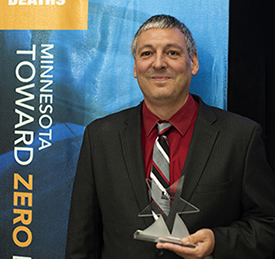
Derek Leuer a TZD Award at the annual TZD conference Oct. 12. Photo by Rich Kemp
|
Minnesota state traffic safety engineer Derek Leuer was among twelve people given TZD Awards at the annual TZD conference, which was held earlier this month in St. Cloud.
The award citation highlighted Leuer’s efforts in “shifting the narrative of safety projects to include more proactive systemwide engineering solutions. By creatively using data to show what engineering solutions will be effective on our roadways and working with MnDOT districts to understand and incorporate these solutions into projects, lives have surely been saved on Minnesota roads.”
The other award recipients from around the state included a paramedic, multiple law enforcement officers, county-level planners and engineers, and student advocacy groups. More details, including full citations for each winner, are listed on the TZD website. |
 |
|

|
 |
TABLE of CONTENTS
|
Reminder: Mentor and sponsor program open for applications |
|
By Frida Alvarez, diversity and inclusion organizational development specialist MnDOT’s mentor and sponsor program is returning in 2023, and applications are now open.
The programs help employees thrive in the workplace by connecting employees with more experienced peers to receive guidance and feedback, identify strengths and opportunities, plan professional goals, build a network and just chat. The programs begin in January and last one year.
Full details were included in the October 5 issue of Newsline.
Two upcoming sessions, both conducted virtually via Teams, will provide more information for anyone interested in participating in the programs, either as a sponsor/mentor or a mentee. (Both sessions will include the same information.)
Thursday, October 20, 12:00 p.m. – 1:00 p.m. (Teams link)
Thursday, November 10, 7:30 a.m. – 8:30 a.m. (Teams link)
To apply for the mentor and sponsor program, please complete this online application. If you have any questions, please contact Frida Alvarez, diversity and inclusion organizational development specialist. |
| |
|

|
 |
TABLE of CONTENTS
|
Reminder: Vote for the Hwy 61 project in America's Transportation Awards |
By Pippi Mayfield (District 1) and Doug Mack

Pedestrians cross Hwy 61 at a new crosswalk in Grand Marais. Photo from District 1 staff
|
As mentioned in the last issue of Newsline, MnDOT’s Hwy 61 project, in District 1, is one of 12 finalists for America’s Transportation Awards. The annual competition, sponsored by AASHTO, AAA and the U.S. Chamber of Commerce, has both a Grand Prize, selected by a jury of transportation industry experts, and a People’s Choice Award, determined by a public vote via the awards program website. Members of the public—including MnDOT employees!—can vote up to one time per day through October 21.
Both awards come with a $10,000 cash prize to be donated to a charity or scholarship of the winning DOT's choosing. If the Hwy 61 project wins, MnDOT plans to use the funds for the Roberta Dwyer Scholarship Fund. Roberta was a well-known project manager in D1 for more than 30 years and worked on many projects, including the Twin Ports Interchange project. The scholarship in her name is for women interested in entering the engineering field.
AASHTO will announce the winners at its annual meeting in Orlando later this month.
The Hwy 61 project focused on improving pedestrian mobility and safety along the North Shore of Lake Superior. This work, which totaled $19.2 million, included narrowing the roadway, building better biking and pedestrian facilities along each side of the roadway and creating an environment where highway traffic would slow down so crossing the roadway would be safer. It also involved innovative land use, creating an attractive roadside environment that includes places to gather and rest, improved green space, and new lighting that improved visibility and safety for pedestrians and bikers while preserving the dark sky environment of the North Shore. |
 |
|
| |
|



